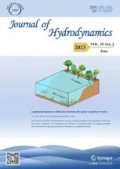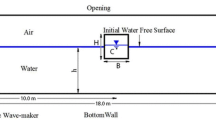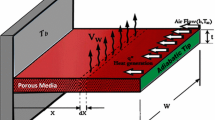Abstract
The process of oil-water displacement is one of the key technologies in offshore underwater tank. When hot oil is contacting the normal-temperature water, the interfacial heat transfer should be investigated as the heat loss may result in wax precipitation and solidification which will reduce the flowing of oil and thus affect the process. As for the numerical simulation of heat transfer, the calculation is costly as the underwater tank is usually large and the displacement period is long. A high precision computing method would greatly reduce the mesh scale. Therefore, this research is performed to establish a high precision computing solver. Based on volume of fluid (VOF), a new form of energy equation is proposed. This equation is derived from temperature equation and the variable internal energy per volume is used. This variable is additive and has a close relationship with volume fraction. With algorithm implantation to OpenFOAM, two non-isothermal VOF solvers are established corresponding to temperature equation and the new equation respectively. After an analytical solution is built, the two solvers are compared. The solver based on the new equation presents far more accurate results than the solver based on temperature equation. An energy weighted scheme is more reasonable than a linear temperature distribution for the mixture phase.
Similar content being viewed by others
References
Sparkman J. C., Foster W. E. The California Company’s new mobile 20,000-bbl underwater storage unit [C]. Drilling and Production Practice, Shreveport, USA, 1961, 7548–7557.
Wang J., Luo Y. Vertical oil storage system and its method for deepwater drilling and production [P]. 2016, U.S. Patent 9,327,805.
Chen Y. C., Feng L. P. Investigation of heat transfer and mathematical model of cement underwater tank for crude oil storage [J]. Acta Petrolei Sinica, 1988, 9(2): 117–126(in Chinese).
Lu P. Q. Study on the heat transfer law for the high pour point crude oil stored underwater [J]. Oil and Gas Storage and Transportation, 1997, 16(8): 4–9, 18(in Chinese).
Xu P. Y., He L. M., Luo X. M. et al. Technical study of oil-water replacement for SDPSO oil tank model [J]. Ship Building of China, 2017, 58(S1): 71–80(in Chinese).
Liu D. X., Wang J., You Y. X. et al. Experimental investigation and numerical simulation of oil-water displacement and storage system of deepwater SDPSO platform [J]. Ship Building of China, 2017, 58(S1): 335–350(in Chinese).
Liu D. X., Wang J., You Y. X. et al. Experimental investigation on oil-water displacement process of a vertical oil storage system in offshore floating platform [C]. The 28th (2018) International Ocean and Polar Engineering Conference, Sapporo, Japan, 2018, 1264–1270.
Zhao M. S., Zhao W. W., Wan D. C. Numerical simulations of propeller cavitation flows based on OpenFOAM [J]. Journal of Hydrodynamics, 2020, 32(6): 1071–1079.
Lin S., Gan Z., Yan J. et al. A conservative level set method on unstructured meshes for modeling multiphase thermo-fluid flow in additive manufacturing processes [J]. Computer Methods in Applied Mechanics and Engineering, 2020, 372: 113348.
Sharma S. L., Ishii M., Hibiki T. et al. Beyond bubbly two-phase flow investigation using a CFD three-field two-fluid model [J]. International Journal of Multiphase Flow, 2019, 113: 1–15.
Agarwal D. K., Welch S. W. J., Biswas G. et al. Planar simulation of bubble growth in film boiling in near-critical water using a variant of the VOF method [J]. Journal of Heat Transfer, 2004, 126(3): 329–338.
Banerjee R. A numerical study of combined heat and mass transfer in an inclined channel using the VOF multiphase model [J]. Numerical Heat Transfer, Part A: Applications, 2007, 52(2): 163–183.
Ahammad M., Liu Y., Olewski T. et al. Application of computational fluid dynamics in simulating film boiling of cryogens [J]. Industrial and Engineering Chemistry Research, 2016, 55(27): 7548–7557.
Han P. P., You Y. X., Liu D. X. et al. A numerical investigation on the heat flow in the process of oil-water displacement in SDPSO [J]. Modern Physics Letters B, 2020, 34(32): 2050364.
Bergman T. L., Incropera F. P., Lavine A. S. et al. Introduction to heat transfer [M]. 6th Edition, New York, USA: John Wiley and Sons, 2011.
Patankar S. Numerical heat transfer and fluid flow [M]. Washington DC, USA: Hemisphere Publishing Corporation, 1980.
Roenby J., Bredmose H., Jasak H. A computational method for sharp interface advection [J]. Royal Society Open Science, 2016, 3: 160405.
Roenby J., Larsen B. E., Bredmose H. et al. A new volume-of-fluid method in OpenFOAM [C]. The 7th International Conference on Computational Methods in Marine Engineering, Nantes, France, 2017, 1–12.
Scheufler H., Roenby J. Accurate and efficient surface reconstruction from volume fraction data on general meshes [J]. Journal of Computational Physics, 2019, 383: 1–23.
Gamet L., Scala M., Roenby J. et al. Validation of volume-of-fluid OpenFOAM® isoAdvector solvers using single bubble benchmarks [J]. Computers and Fluids, 2020, 213: 104722.
Moukalled F., Mangani L., Darwish M. The finite volume method in computational fluid dynamics [M]. Berlin, Germany: Springer, 2016.
Perry R. H., Green D. W., Maloney J. O. Perry’s chemical engineer’s handbook [M]. 8th Edition, New York, USA: McGraw-Hill, 2008.
ITTC. Recommended procedures and guidelines: uncertainty analysis in CFD verification and validation methodology and procedures [R]. International Towing Tank Committee Report, 7.5-03-01-01, 2017, 5–6.
Acknowledgement
This work was supported by the Sci-tech Project of Sanya Yazhou Bay Science and Technology City Administration (Grant No. SKJC-KJ-2019KY08).
Author information
Authors and Affiliations
Corresponding author
Additional information
Projects supported by the National Natural Science Foundation of China (Grant No. 51809163).
Biography
Pan-pan Han (1990-), Male, Ph. D., E-mail: hanpanpan@sjtu.edu.cn
Rights and permissions
About this article
Cite this article
Han, Pp., Chen, K., Liu, Dx. et al. A high precision computing method for heat transfer in the process of oil-water displacement. J Hydrodyn 33, 958–969 (2021). https://doi.org/10.1007/s42241-021-0085-x
Received:
Revised:
Accepted:
Published:
Issue Date:
DOI: https://doi.org/10.1007/s42241-021-0085-x




